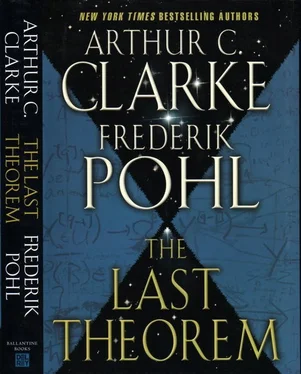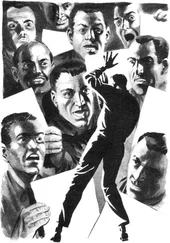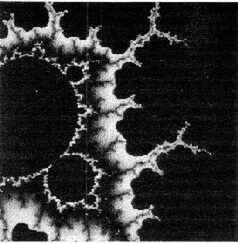Then, Myra insisted, it was time for lunch. And friendly talk. A lot of it. Surash wanted to hear all about Ranjit’s work at the university, and Natasha’s hopes for using some of her sailing skills at the great solar-sail space race that was to take place in just over a year, and Robert’s surprising skills at putting jigsaw puzzles together, and Myra’s struggle to keep up with the rest of her cohort at her profession. And even more he wanted to tell them how things were at the great temple in Trincomalee and where he had been in his new car—all up and down the island, he boasted, in his effort to complete a long longed-for pilgrimage to Sri Lanka’s most famous Hindu temples—and, most of all, how well the car had worked.
And where had this wonderful new machine come from? “Korea,” Surash said promptly. “They’ve just begun marketing it, and one of our people was able to get this one for me. Oh,” he said, almost jubilant, “isn’t it fine that with so much less of our efforts going into wars and preparing for wars we’re able to do so much more in other ways? Like that thing they call a nuclear quadrupole resonance detector that they use to find buried land mines, and then there’s a thing like a little robot on caterpillar treads that comes along and clears the dirt off the mines and puts them away and no one gets hurt! They’ve cleaned up almost all the old battlefields near Trinco now. And they’ve got that gene-spliced hormone spray that’s tuned to the DNA of the mosquitoes that carry the bending disease, and they’ve got little robot planes that go around and spray them dead. And much more. We owe a lot to that Silent Thunder!”
Ranjit nodded, looking at his wife. Who tossed her head and said, “I never said it was all bad, did I?”
• • •
When Surash was finally gone, his peculiarly complex car sputtering steam as it pulled away from the house, Ranjit came back inside. “He’s a wonderful old man,” Myra told him.
Ranjit agreed without hesitation. “Do you know where he’s been in that contraption? He started at Naguleswaram, north of Jaffna. I don’t know how many other temples he visited, but when he was at Munneswaram, he was just north of Colombo, and of course he could not visit the city and not stop to see us. Now he’s heading south to Katirkamam, although that temple’s more likely to be used by Buddhists these days. And I think he’s going to pay a visit to the Skyhook terminal, too.” He hesitated, then added thoughtfully, “He’s very interested in science, you know?”
Myra gave him a sharp look. “What is it, Ranjit?”
“Oh….” He gave it a dismissive shrug that did not quite dismiss the subject. “Well, the first thing he said to me outside was he reminded me that I still owned my father’s old house and it was just sitting there vacant.”
“Well, but your work’s here,” Myra told him.
“Yes, I said that. Then he asked me if I was surprised that he talked about scientific things like his new car so fluently. And he said, ‘But I learned from your father, Ranjit. One can believe in religion and still love science.’ And then he looked really serious and said, ‘So what about the opposite? Can one love science and still honor God? What of your children, Ranjit? What sort of religious education are you giving them?’ And he didn’t wait for an answer because he knew what the answer would be.”
“Ah,” Myra said, because she knew what the answer would have to be, too, and knew that hearing it would have hurt Surash. They had discussed the matter of religion long since, she and Ranjit, and they were of the same mind. If Ranjit quoted one obscure twentieth-century philosopher’s “All religions were invented by the devil to hide God from mankind,” she might retort with, “The greatest tragedy in mankind’s entire history may be the hijacking of morality by the church. The church doesn’t know what to do with morality. It thinks morality is defined by the will of a nonexistent person.”
Still, Myra knew how fond her husband was of the old monk. Lacking any ideas that would satisfy them all, she changed the subject. “Did you see what Robert was doing for Surash when you were coming in?”
He blinked at her. “No—oh, wait a minute. He was doing one of his little jigsaws, wasn’t he?”
“Not so little, Ranjit. That was a five-hundred-piecer he did in the kitchen. And there’s something else he’s been doing.”
She stopped there, smiling. Ranjit took the bait. “Are you going to tell me what that is?” he demanded.
“I’d rather show you. Let’s go up to his room.” She wouldn’t say anything more until they were there. Robert, sitting before his screen and its pictures of animals, looked up with a big smile on his face. “Robert, dear,” his mother said, “why don’t you show your dad your pentominoes?”
The news that his son was interested in pentominoes wasn’t entirely a shock to Ranjit. He had been fascinated by them himself, at the age of five or six, and he was the one who had first tried to interest the boy in them. He had patiently explained the little tiles to Robert: “You know what a domino looks like, two squares stuck together. Well, if you stick three squares together, you call it a trimino, and it can take two shapes—one that looks like a capital I, the other a capital L. Do you see what I mean?”
Robert had peered gravely at his father’s demonstration but wouldn’t commit himself about understanding. Nevertheless Ranjit had plunged on. “If you go to four squares, together it’s called a tetromino, and it can take four shapes—”
He drew swiftly:

“Rotations and reflections don’t count,” he added, and then had to explain what rotations and reflections were. “None of the tetromino shapes is particularly exciting, but when you go to five squares stuck together, things start to happen!” Because, he said, there were twelve of the five-squared pentominoes. When you put them all together, you had a tiled surface of sixty squares.
Which immediately raised the question: Could you tile a surface of sixty squares—say, a five-by-twelve rectangle, or a long, skinny two-by-thirty rectangle—using all twelve pentominoes, so that the whole surface was covered and no squares were left over?
The answer—which had fascinated five-year-old Ranjit—was not only that you could but that you could do it in no less than 3,719 ways! The six-by-ten rectangles had 2,339 ways of tiling, the five-by-twelves had 1,010 ways, and so on.
How much of what he’d been saying had gotten past Robert’s cheerfully affectionate mask Ranjit could not have said. Then Robert had obligingly switched the program on his learning computer. At once it had begun to roll off images of different pentomino tilings—all of the tilings for the five-by-twelves, then the six-by-tens, and so on to the very end.
Ranjit was now startled and delighted in almost equal amounts. The “handicapped” Robert had identified and displayed every last one of the pentomino tilings—a task that Ranjit himself had given up on all those years ago! “I—I—I think that’s grand, Robert,” he began, reaching out to his son for a hug.
And then he stopped, staring at the screen.
It had completed the display of pentomino patterns. What Ranjit expected it to do then was to turn itself off. It didn’t do that. It took the next step and went on to seek hexomino patterns.
Ranjit had never mentioned hexominoes to his son. It was too complicated a subject for Robert to have any hope of grasping it, Ranjit was sure. Why, there were thirty-five different hexominoes, and if you spread them all out, they covered a surface of two hundred ten units. And that was where young Ranjit had found them unwelcomely disappointing in those long-ago days of his childhood. Any rational person would think that a truly astronomical number of those two-hundred-ten-unit rectangles could be exactly covered by the thirty-five hexominoes. That person would be wrong. Not a single rectangle, whatever the ratio of its sides, could be tiled by the hexominoes in any pattern at all. Always, irreparably, there would be at least four empty spaces left over.
Читать дальше
Конец ознакомительного отрывка
Купить книгу











